A Sacramento plaque has a mistake about the Holocaust. Critics say that’s not the only issue
- Oops!Something went wrong.Please try again later.
The facts surrounding one of Nazi Germany’s first concentration camps are as horrific as one might imagine.
Dachau opened just weeks after Adolf Hitler came to power in 1933. Willie Aron, a young Jewish lawyer who tried to hold Nazis legally responsible for mob violence, was among the first killed there. There would be many more.
Between 1933-1945, tens of thousands of Jews and others targeted by the Nazis were brutally tortured and killed at the camp.
A recently erected plaque in Curtis Park, commemorating the still-under-construction Petrovich Family Playfields adjacent to Crocker Village, pays tribute to the liberation of the camp.
But, in doing so, it also contains an embarrassing factual error that raises questions not only about how the city could have allowed such a mistake but, more broadly, how the city allowed the plaque to be placed there in the first place.
The plaque celebrates Bronze Star recipient Alexander “Pete” Petrovich, who is the father of Paul Petrovich, the developer of Crocker Village. The plaque honors Pete Petrovich for “guiding his troops during the initial liberation of the Dachau Concentration Camp in Poland.”
And therein lies the problem. Dachau is not in Poland. It’s in Germany, near Munich — over 500 miles from the Polish border.
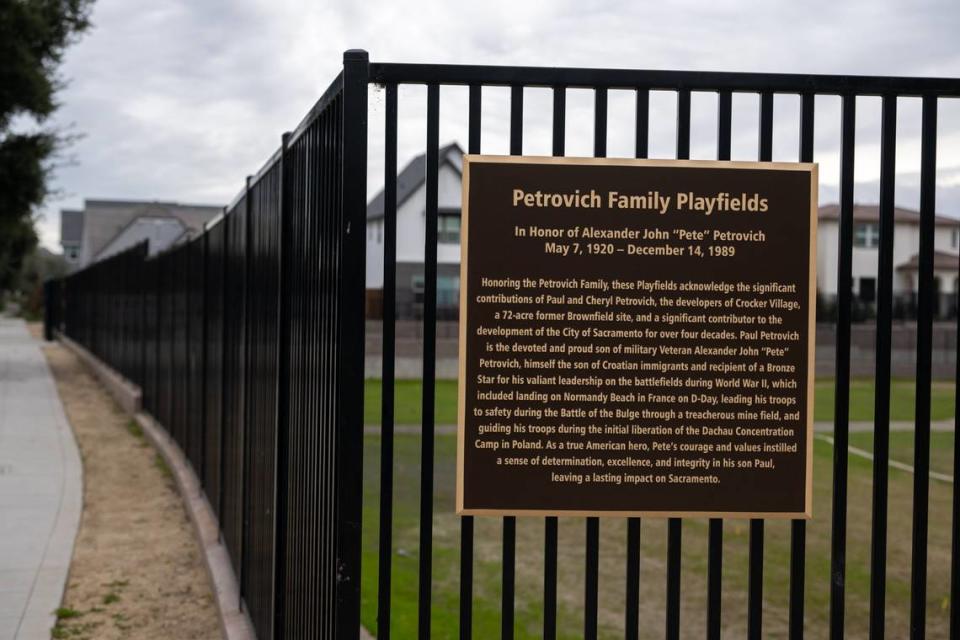
Rabbi Erez Sherman of Sinai Temple in Los Angeles, who has been involved in multiple projects memorializing the Holocaust, said that such a basic mistake on a public plaque is troubling.
“There is so much disinformation out there,” Sherman said, “which makes it especially crucial to be accurate.”
A sign’s origin story
The origin of the city’s sign embarrassment traces back to a bitter dispute over the name of the park. And here’s where the story turns a bit more perplexing — and troubling — not only to those concerned with historical accuracy, but also to those who wish to honor the legacy of Ray Eames, a trailblazing mid-century-modern designer who spent her formative years a stone’s throw away from the park.
Petrovich, citing his contributions to the city, including the Crocker Village development in a former brownfield, became furious in 2019 when he was told by the city that he had to go through a competitive process in order to have the park named after his family.
One of the other names to be considered was Eames.
As he lobbied for his right to name the park, Petrovich submitted an eight-page letter to the city.
“Naming the park after the Petrovich Family,” he wrote, “is not only appropriate, to do otherwise is simply an overt act of bias and a hateful act by a handful of people to inflict severe bias towards a family that has contributed so greatly to Sacramento and the region as a whole.”
The Parks and Recreation Committee thought otherwise. In August, 2019, they voted 10-1 to recommend naming the six-acre park Ray Eames Park. A month later, the City Council unanimously agreed.
Ray Eames’ contribution
Born in 1912, Eames attended elementary school in what is now the Sierra 2 Center for the Arts & Community, where she first developed her love of painting and drawing. Her father was the general manager of the Empress Theater (today the Crest).
Eames, along with her husband, Charles, are notable figures in the design world. Many iconic Eames chairs are still in production. The sets of the hit drama “Mad Men” were often adorned with Eames furniture, including Don Draper’s executive chair.
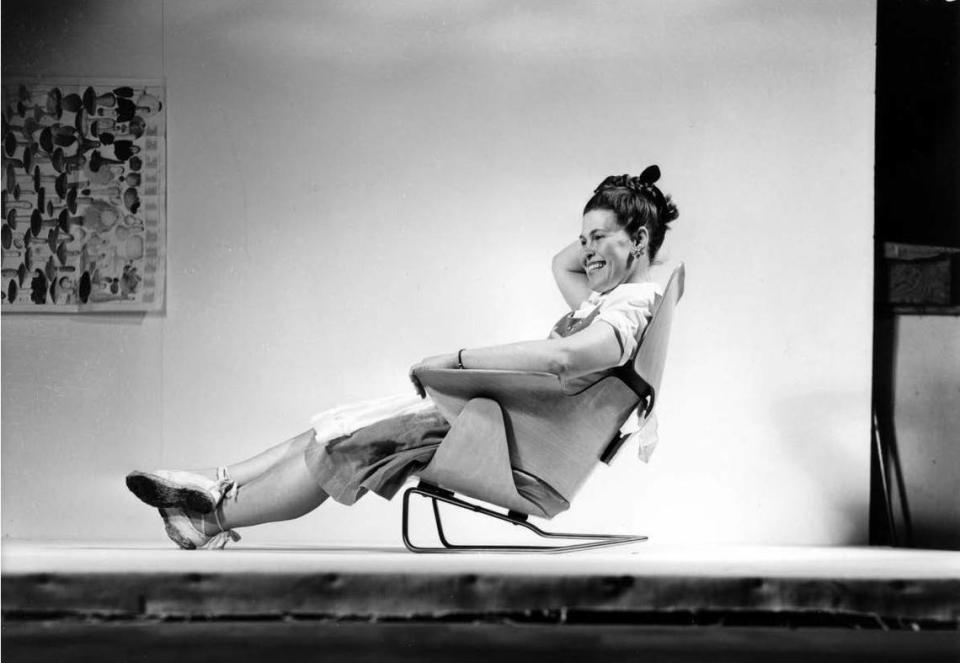
After learning during World War II that metal leg splints were causing further injury, Ray and Charles created a molded wooden leg splint used by an estimated 150,000 soldiers. The Postal Service honored Ray and Charles with a series of stamps in 2008.
Before casting her vote to name Eames Park, Councilwoman Angelique Ashby said, “I’d hate to see another man cast her in the shadows. I would rather see her own her space – and own it outright.”
One might think that unanimous vote would be the end of the story. It wasn’t.
The gas station lawsuit — and settlement
In 2015, the City Council had rejected Petrovich’s proposal to build a gas station in Crocker Village. Petrovich sued, spurring a costly seven-year legal battle that included Petrovich filing yet another lawsuit over the matter last year.
In August, following a string of legal setbacks, the city agreed to apologize and to purchase a K Street building from Petrovich for $18.5 million, and then pay him an additional $7.5 million. The $26 million cost to settle is more than the city spends annually on homelessness.
Buried in the fine print of that settlement was an additional concession to the developer. It essentially split the 6-acre park into two, with the vast majority to be named the Petrovich Playfields. About half an acre — a fraction of the park site — would be allowed to have the Eames name on it.
“The City shall not permit, approve, or install any signage, statue, plaque, or other memorial within the area of the playfields,” other than “the Petrovich Family Playfield sign and plaque,” the settlement states.
Ray Eames’ descendants, as well as people who advocated for the larger Ray Eames Park, are disappointed, especially because they had envisioned elements of Eames’s design integrated into the park, and, because a fitting testament to Eames in Sacramento is long overdue.
“The Petrovich family was quite gracious acknowledging Ray’s achievements in conversation at the board hearing I attended,” Ray Eames’ grandson Eames Demetrios told The Bee, adding that he thought Petrovich’s father is also worthy of honor. “The physical courage required of him to engage in combat on D-Day is difficult for any of the rest of us to fully comprehend.”
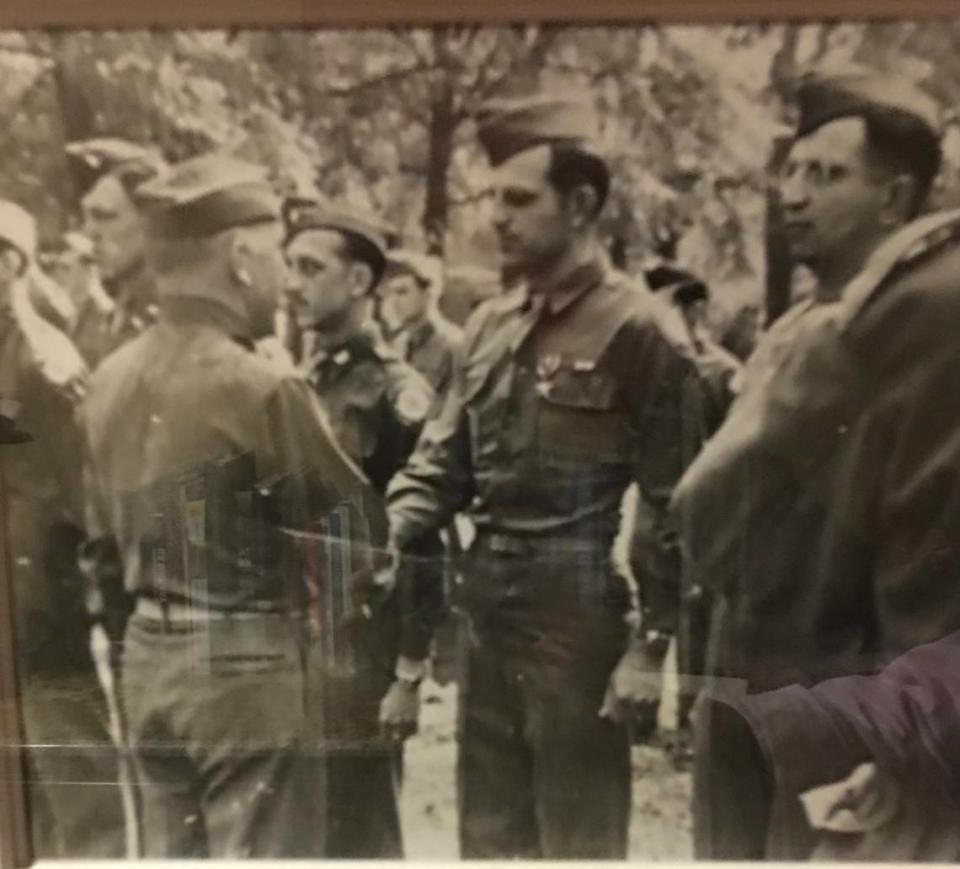
But, he added, “The difficult part here is that a years-long process which involved a lot of people on all sorts of sides of the issue of naming the park reached a thoughtful conclusion four years ago.
“That conclusion named a meaningfully sized Sacramento park for Ray Eames and would have ensured that her name and story would have been told and retold by generations of families in the context of fields of play—and there was of course the delightful connection to Ray’s actual home, which offered a unique narrative. And yet for reasons apparently unrelated to the content and substance of the public hearing process, this honor is gone as if none of that work ever happened.”
The city offered no explanation as to why it agreed to reverse the earlier process. Spokeswoman Gabby Miller said, “The decision to name the playfield after the Petrovich family was part of the City’s settlement with Petrovich. The playfield naming was approved by the City Council on Oct. 3, 2023.”
How Dachau ended up in Poland
The settlement not only allowed for the Petrovich Family Playfields but also included the specific language on the plaque — including the historical inaccuracy.
The language appears to have been written by Petrovich’s representatives. Petrovich said the rest of the language in the plaque, including the list of his father’s accomplishments, is accurate.
Tim Swanson, a spokesman for the city told The Bee in an email, “Yes, the City regrets any inaccuracy in its signage and will work to correct it.”
Petrovich told The Bee, “It was a mistake, I don’t know who made it.”
He added, “You know what I love about this? That this is occupying so much of these people’s brain space…This has been an ongoing battle where these people can’t stop and have no life, and I am getting enjoyment out of them continually beating their head against the wall trying to defeat me and change things after they thought they had their way.”
‘Classic Petrovich’
On a recent Sunday, several neighbors gathered near the plaque, voicing frustration not just about the erroneous plaque but that the park was nowhere near complete.
“This outcome is classic Petrovich,” said Curtis Park-based real estate agent Steffan Brown. “I don’t always agree with Paul’s critics; he has done some impressive work in Sacramento and I think most people would agree that Crocker Village is an accomplishment that improved the neighborhood. But he doesn’t like to lose and he doesn’t like to be crossed.”
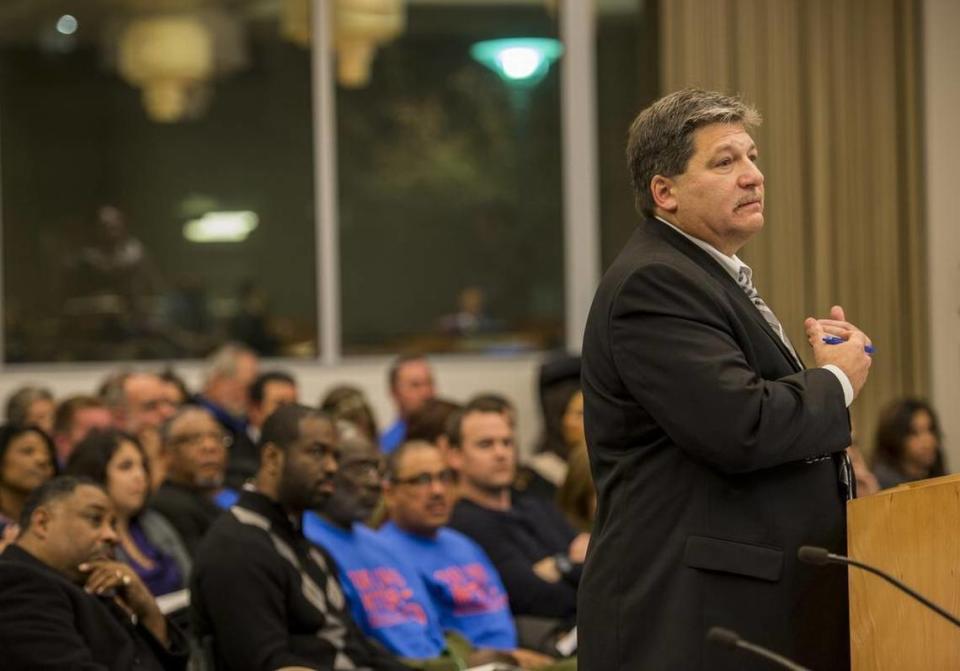
Petrovich acknowledged that the park issue was not explicitly a part of the original lawsuit. But he said “it was part of my overall emotional duress and violation of my rights. And so you know, there’s a process for naming parks. And I followed it to the letter, and the city agreed to allow me to name the park after my father.”
For the moment Petrovich Family Playfields and Eames Park seem like an uncomfortable marriage. At present, there are few, if any, Eames design elements planned for the smaller part of the park.
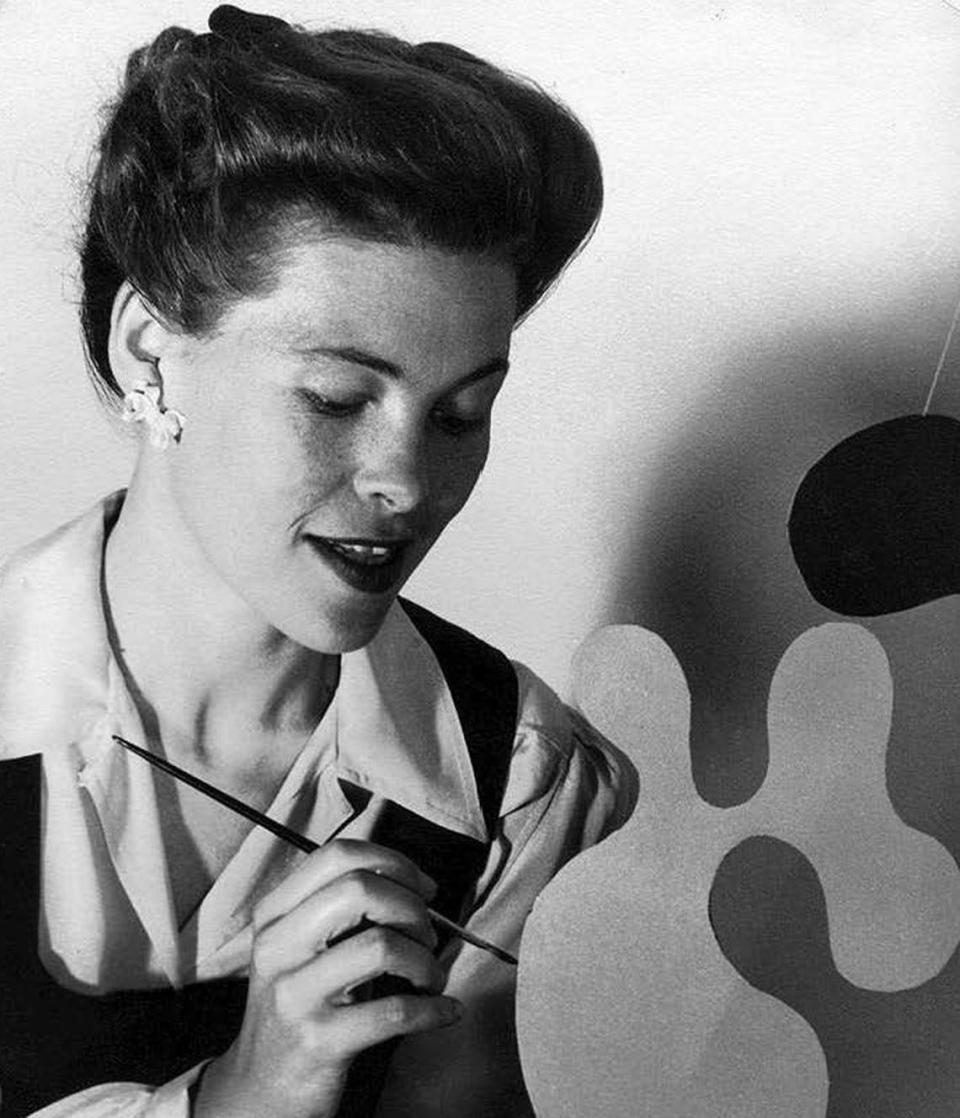
Petrovich told The Bee that play equipment, a shade structure, landscaping and an arched slabbed concrete sign with Eames name and the city’s logo should be in place by April.
Gretchen Steinberg, who in 2014 was one of the driving forces behind a 2014 retrospective of Ray Eames work at the California Museum, said the controversy has dulled excitement over a Ray Eames park. The planned slabbed concrete sign, for example, she said, “seems like standard parks and rec signage, sort of antithetical to her style.
“Her designs in particular have a playful sense of color, balance, texture and proportion,” Steinberg said. “And I was really looking forward to the park being colorful and fun and exciting.”

